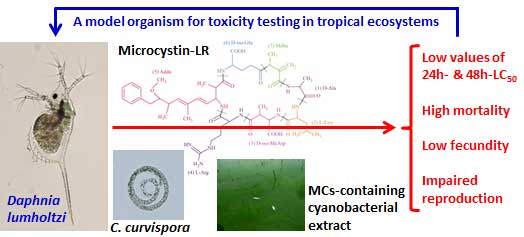Responses of a tropical micro-crustacean, Daphnia lumholtzi, upon exposures to dissolved toxins and living cells of cyanobacteria
11/11/2020 1:00 PM GMT+7 TP HCM

SEMINAR: Responses of a tropical micro-crustacean, Daphnia lumholtzi, upon exposures to dissolved toxins and living cells of cyanobacteria
10 AM Tuesday, 17th November, 2020 - CARE meeting room (B7, 1st floor)
Thi-My-Chi Voa, Ba-Trung Buib,c, Claudia Wiegandd, Khuong V. Dinhe,f, Thanh-Son Daog*
aInstitute of Research and Development, Duy Tan University, Da Nang, Vietnam.
bInstitute for Environment and Resources, VNU-HCM, 142 To Hien Thanh St., Dist. 10, Hochiminh City, Vietnam
cAquatic Ecology & Water Quality Management Group, Department of Environmental Sciences, Wageningen University, P.O. Box 47, 6700 AA Wageningen, The Netherlands
dUniversity Rennes 1, UMR 6553 ECOBIO, Campus de Beaulieu, 35042 Rennes Cedex, France
eSchool of Biological Science, Washington State University, Pullman, WA, U.S.A.
fDepartment of Fisheries Biology, Nha Trang University, Nha Trang City, Vietnam
gHochiminh City University of Technology, VNU-HCM, 268 Ly Thuong Kiet St., Dist. 10, Hochiminh City, Vietnam
* Corresponding author Email address: dao.son@hcmut.edu.vn (T.S. Dao)
The mass development and expansion of cyanobacteria release cyanotoxins in the aquatic environment and cause serious problems for grazers such as micro-zooplankton. In contrast to aquatic ecosystems in temperate regions, impacts of cyanobacteria and their toxins on tropical micro-crustaceans are relatively understudied. In this study, acute and chronic effects of pure microcystin-LR (MC-LR), a crude extract of water bloom sample with a dominance of Microcystis aeruginosa containing microcystins (MCE) and living cells of Cylindrospermopsis curvispora were tested on a tropical micro-crustacean, Daphnia lumholtzi. The 24h– and 48h–LC50 values for MC-LR ranged from 247 – 299, and 331 – 409 µg MCE L-1, respectively. Exposures to 1 – 25 µg MCE L-1 decreased survival, fecundity, and reproduction of D. lumholtzi. The impacts of C. curvispora cells on life-history traits of D. lumholtzi were density-dependent and more severe than the impacts of dissolved microcystins. It could be that the adverse effects of C. curvispora on D. lumholtzi are linked to a combination of potential toxic metabolites, mal-nutrients, feeding and swimming interference. Daphnia lumholtzi used in this study is more sensitive to microcystins compared to Daphnia species from temperate regions. Therefore, we highly suggest using D. lumholtzi as a model species for toxicity testing and monitoring on water quality, particularly in tropical countries.
Keywords: acute lethal concentration, clutch size, Cylindrospermopsis curvispora, microcystins, reproduction, survival proportion
Related news
The Scientific Council meeting of Centre of Water Research in Asia (CARE)
On 22/10/2015, CARE has organized the meeting of the Scientific Council with the chairmanship of Dr. Nicolas Gratiot - Director and Chairman of the Scientific Council, Assoc. Pro. Vo Le Phu (on behalf of Assoc. Pro. Nguyen Phuoc Dan - Deputy Chairman)
22/10/2015
USTH_2016: Call for PhD. Candidate 2016 in remote sensing.
Project description The availability of High Resolution Imagery (spatial, spectral, and radiometric) with an increased time revisit (Landsat-8 and now Sentinel-2) opens the way to a more detailed observation of coastal zones and inland waters (large rivers, lakes and reservoirs)
26/02/2016
RD DELEGATION VISIT CARE-RESCIF
On 08 September 2016, the delegation from Institute of Research for Development (IRD – France) led by Mr. Thierry Lebel - Director of the Promotion of Interdisciplinary and Intersectoriality and Mr. Frédéric Ménard
02/09/2016
UNESCO Monography: HCMC growing with water-related challenges
The pretty work, a monography collection of 15 megacities in the world about "Water, megacities and Global Change”, has been published by UNESCO. The CARE Lab-HCMUT Researchers are honored to represent Ho Chi Minh City by contributing an article
11/10/2016
Fulltext of the Monography "Ho Chi Minh City growing with water-related challenges" available
CARE Lab-HCMUT is pleased to present you our publication of the monography "Ho Chi Minh City growing with water-related challenges".
31/10/2016
CARE Lab-HCMUT at the environmental technology exhibition POLLUTEC, Lyon
CARE Lab-HCMUT and PADDI, a member of the Ho Chi Minh City delegation, participated in the 26th Environment exhibition POLLUTEC, Lyon (France), which took place from 30/11 to 02/12/2016.
22/12/2016
SUJETS DE STAGE AU CARE-Rescif 2017
Tuteur: Dr. BUI Xuan ThanhAssociate Professor in Environmental Engineering,Head, Department of Water Science & Technology Faculty of Environment & Natural Resources
11/01/2017


1094